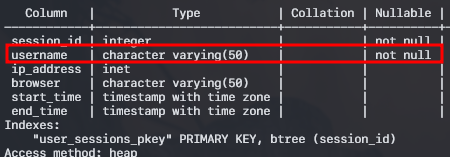In this tutorial, we will walk you through adding a NOT NULL constraint to a table column in PostgreSQL. We will cover the basic syntax, examples, and points to note when working with a NOT NULL constraint.
Requirements:
To follow along with this post, we assume that you have the following:
- Installed and running PostgreSQL database
- Basic knowledge of SQL and PostgreSQL syntax
Let’s proceed.
Connecting to PostgreSQL Server
Ensure that you are connected to the PostgreSQL server to perform the queries in this post. For basic administration, you can use the psql command-line tool.
Create a Table and Sample Data
Let us set up a basic table and add a sample data for demonstration purposes. Feel free to skip this section if you already have an existing table that you wish to use.
session_id SERIAL PRIMARY KEY,
username VARCHAR(50),
ip_address INET,
browser VARCHAR(50),
start_time TIMESTAMPTZ,
end_time TIMESTAMPTZ
);
-- Insert sample data
INSERT INTO user_sessions (username, ip_address, browser, start_time, end_time)
VALUES
('user1', '192.168.0.1', 'Chrome', '2023-05-15 10:00:00', '2023-05-15 11:30:00'),
('user2', '192.168.0.2', 'Firefox', '2023-05-15 12:00:00', '2023-05-15 13:15:00'),
('user1', '192.168.0.3', 'Safari', '2023-05-15 14:30:00', NULL);
The previous query creates a user_sessions table that stores the user session information such as the username, IP address, browser, start, and end time.
The resulting time is as follows:
Identify the Target Column
Before you can create a NOT NULL constraint to a given column, it is good to ensure that the target column exists.
Let us take the “user_sessions” table that we created. Our goal is to implement the NOT NULL constraint to the username column.
Add the NOT NULL Constraint
We can use the ALTER TABLE statement with the ALTER COLUMN clause to add a NOT NULL constraint to a column
The syntax is as demonstrated in the following:
Example:
The given query should add a NOT NULL constraint to the username column in the user_sessions table.
Verify the Added Constraint
Once we add the constraint, we can check the table information to verify using the \d+ command in psql.
Example:
This should return the detailed information for the user_sessions table. Locate the NULLABLE column. The username column should show “NOT NULL”.
Test Constraint
To test the newly added NOT NULL constraint, insert a row into the table without specifying a value for the target column.
For example, let us attempt to a null value to the username column in the “user_sessions” table.
values ('192.168.0.1', 'Chrome', '2023-05-15 10:00:00', '2023-05-15 11:30:00');
This should return an error which indicates that the insert violates the NOT NULL constraint.
SQL Error [23502]: ERROR: null value in column “username” of relation “user_sessions” violates not-null constraint.
Handling NULL Values
It is good to keep in mind that the NOT NULL constraint only applies to the values that are inserted after the constraint is added. Hence, it does not affect any NULL values that exist before it.
For that, you can use the features such as the DROP statement to remove the NULL values as shown in the following:
This should drop all the rows that contain a NULL value in the specified column.
You can also update the table to add a default value for any row that contains a NULL value in the specified column.
For example, you can run the following:
The given query should insert the NIL value to all NULL rows.
Conclusion
You now learned how to add a NOT NULL constraint to a column in a PostgreSQL database.


